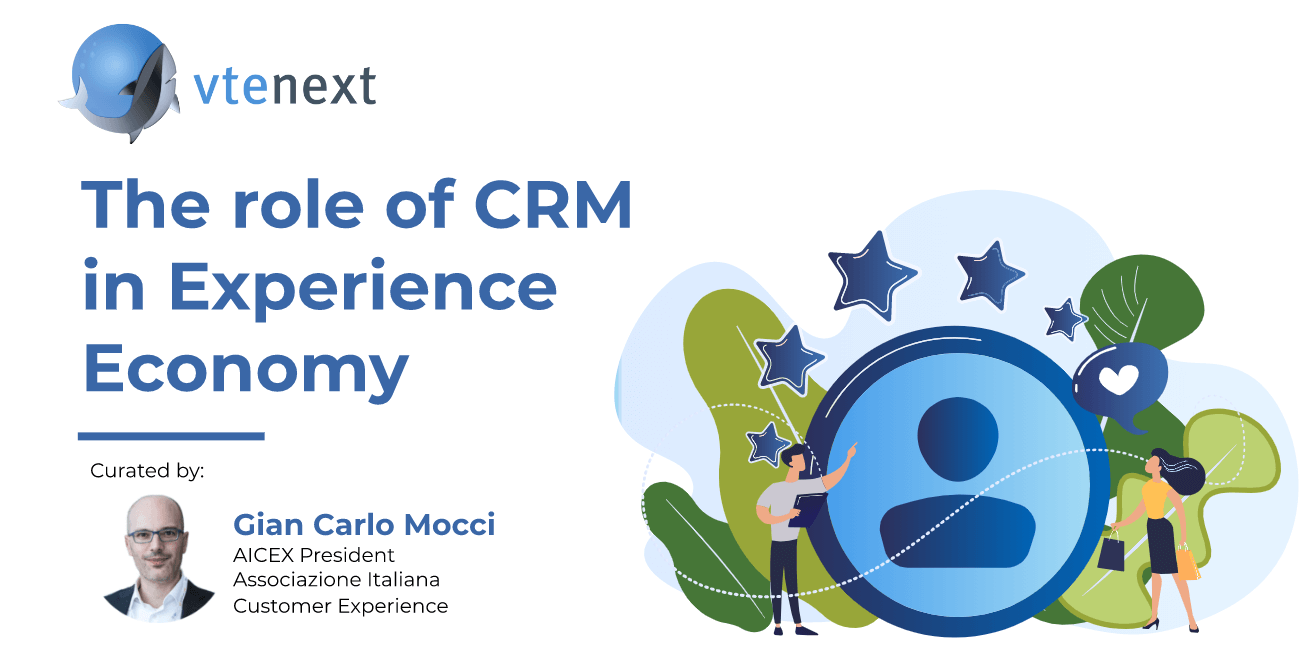Aware of the fact that CRM is not only a software, but also a change of mentality, those companies who want to embrace the huge opportunities offered by experience economy, need to know how to value technology’s contribution in order to win the challenges of a constantly changing world.
Many organizations struggle to interpret the needs, wishes and expectations of the customers and the market in general, and this makes establishing a relationship difficult. On their part, people are less sensitive to price and compare the experiences they lived with a company not only with those of direct competitors, but also with the ones of companies in different markets and fields.
This means that the customer compares the UX of a shipping company’s app with that of a fintech, the experience of a Booking reservation with that of an airline company, Amazon’s payment method with that of a hotel chain, an online bank’s customer service with that of a telco, the self-service portal of a utility with that of an online insurance.
Moreover, the effects of the pandemic have contributed to the phenomenon that Mckinsey called “Shock to Loyalty”, which occurs with a reduction in loyalty, an increase in opportunistic behaviours, and the research and use of new suppliers for products, services and experiences. In addition the customer, used to the “everything everywhere instantly”, lives in a world in which immediacy is a mixture of whim and addiction.
Moving from how customers spend to why they spend by working on internal and external processes
Therefore, if once one focused exclusively on how and where customers spent, today it is also necessary to pay attention to the why factor: why a person should choose and pay for the products, services, and experiences offered by a company instead of those offered by another.
In this “liquid context”, companies need to intervene on the processes to improve, modernize and automate them while creating new ones, with an attitude towards continuous improvement, which pervades the whole organization and not only the touch points and processes involving the customers first hand. In fact, back-end efficiency impacts on front-end performances being it about plants, people or processes; just think about the role of logistics in an e-commerce or at the training of customer service operators.
Furthermore, the actions on internal processes also help facing competitors, who have greater difficulties in replicating products, processes and services that are not directly visible to them, even since now more than ever, many front-end activities are based upon technological solutions that are freely available in the market. Therefore, if having the same technology is easy and replicating front-end processes is possible, then knowing and replicating the contribution of back-end processes becomes more difficult for competitors.
Those who act on both internal and external processes substantially differentiate themselves from competitors, and acquire competitive advantage, with the same technology and financial resources spent.
In order to give a visual representation for this approach we can say that it is also necessary to act below the line of visibility of the customer journeys, which, if done right, should not only represent some of the journeys of customers at this point, but also some of the company’s ones. This explains why, who has correctly interpreted an approach based on customer experience, has always extensively considered the term “customer”, by considering external, internal and potential customers, until reaching partners and suppliers.
CRM is a corporate culture, a change of mindset that transforms the way of working, internal and external processes, as such it needs to be an integral part of the overall strategy thought for guiding the company towards a customer focused approach. All these things improve the customers’ experiences and enable the company to identify metrics, assign priorities and guide investments. Moreover, business managers are motivated to reconsider their role and their activities in such a way to offer an active contribution to the achievement of the business goals.
In this perspective, the CRM as a technological system becomes a key element for both internal and external processes, which are directly perceived by the client. For this reason, it is important to foresee solutions that are quite scalable and embeddable rather than monolithic, even in systems used by other areas such as customer service, marketing automation, digital marketing; without neglecting logistics, accounting and procurement management.
Solutions of this kind offer many advantages, among which the possibility to:
- progressively adapt according to business developments and objectives, allowing to split expense budgets;
- improve business continuity;
- act more efficiently in workflow automation activities, in order to release man-hours, boost performance and reduce costs.
The data topic deserves a dedicated thinking: once, we frequently talked about “silos” to indicate sealed off compartments, which were often trapped into the technological platforms that generate and/or contain them. However, the introduction of technological CRM solutions brought many improvements, in a path started from the first databases housed in company servers to today’s cloud solutions.
This path enabled to release the data and put them at the various business functions’ disposition until arriving to datalakes. On the other hand, thanks to the cloud, we now have both a multitude of technologies that can dialogue with each other by using the same data bases, and solutions able to work on a multitude of sources of data and regroup them organically, think about CDPs Customer Data Platforms.
The modern CRM solutions play an irreplaceable role inside the company, they are in cloud, they can share data with the most diverse technologies while remaining the most important source of information.

If we automate an inefficient process, we automate its inefficiencies too; this is why it is important first to understand if, and how, such process is improvable, or if instead it can be delated.
We often automate processes with the purpose of minimizing the involvement of people, increasing performance and reducing costs. The application of this logic in a short-sighted way has already created several imbalances in many companies and, as a consequence, on their customers even more.
The workflow automation dynamics should be thought on at least two levels, the internal and external processes, in order to properly plan the repercussions on the people involved, be it about customers, employees or suppliers. Moreover, it is necessary to consider both the already existing processes, and those that are still to be designed, by doing whatever it takes to release people from new low-value tasks.
Thus, the delegation of processes and services that are highly repetitive, time consuming and hardly rewarding, to algorithms and machines, is the solution. In this way, the man-hours saved by the company can be used in higher value-added tasks.
Besides, it is well known that one of the reasons behind the failure of CRM projects is the failure in user adoption too: if employees perceive the introduction of new technologies as an extra duty, the roots for the successful outcome of any initiative are lacking. The increased gratification of employees goes in favour of productivity, and greater customer satisfaction brings direct benefits for the business. In this way, technologies and processes will be seen as bearers of improvement, efficiency and happiness.
A process that is automated with criteria satisfies everyone, for the benefit of the company’s balance sheet.
In addition, sometimes it is possible to use automation solutions that carry out specific tasks in a quick and precise way, thanks to the implementation of “plug-ins”, and this explains the existence of marketplaces devoted to these solutions even now, which resemble to the smartphones’ app stores. Companies will be able to free their imagination without worrying too much about the budget.
People are now used to the level of the services and experiences offered by the best companies. This means that it is even more difficult to stay on track and differentiate, and acting exclusively upon the touchpoints with customers is not enough to be able to do this, but it is also necessary to include the entire organization.
It is also essential to understand and anticipate the behaviour of the market and competitors, and in order to do it, it is important to enhance the data and information that one already has, but also to collect new ones, for example through listening and feedback collection activities, like the famous CFM Customer Feedback management.
The fast and unpredictable changes that we need to face require a strict but flexible approach, for which it is not necessary to invest more, but to invest differently and better, in order to do things that are new, but also to do the same things in a new way.
The challenge is that of offering valuable experiences to customers, by keeping in mind that all the customers are persons, but the inverse is not true.
Get the most out your CRM solution, digitize and automate your business processes:
Article written by:
Gian Carlo Mocci
President of AICEX Italian Customer Experience Association

